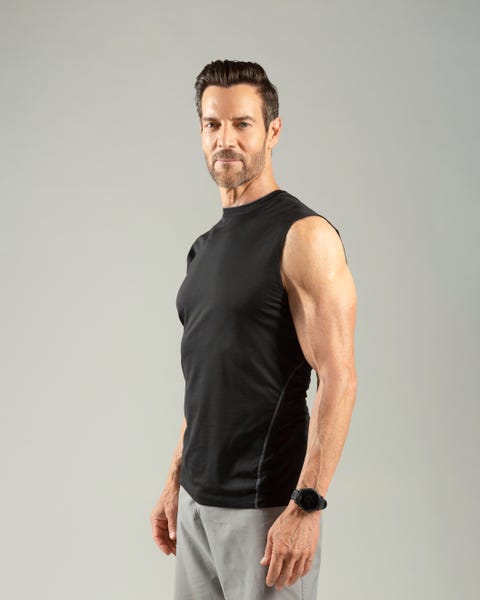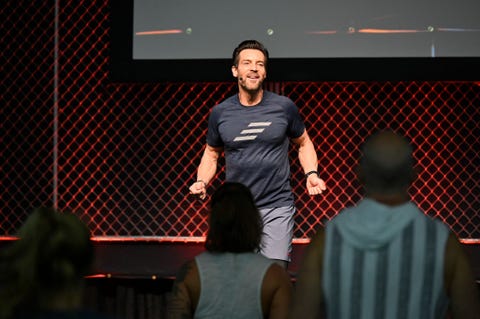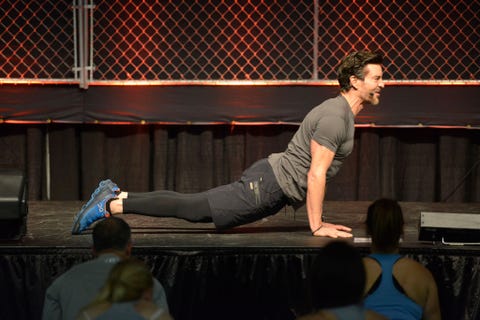P90X’s Tony Horton Shared the Workout Tips He Uses to Stay Shredded
Almost 20 years after becoming a household name by telling P90X users to “bring it,” Tony Horton is still bringing it. The 64-year old lifts three days per week, does yoga on Saturdays, and spends the rest of the week out in his “yard”—climbing ropes, working on parallel bars, doing sprints, and training on his at-home ninja training course.
“Yesterday, we were out there for four hours, and I was able to do pretty well with the youngsters,” he says. “One of the things we did was up and down the 20-foot rope twice, timed. So you go all the way up, come down all the way, then hit it a second time. My buddy Scott did it in 14 seconds, Mine was 19.”
Even with six days of training, Horton finds time to work on his program, The Power of 4, design and appear in workouts for Tonal, and work on creating his own sports nutrition products, called Power Life.
With that kind of schedule, you’d think he’d burn out—and he almost did. In 2017, Horton contracted a type of shingles outbreak called Ramsay Hunt syndrome. He lost 25 pounds, and could have had permanent nerve and eye damage.
“I was burning the candle at both ends,” he says. So in addition to his grueling training and work schedule, Horton found time to add in mindfulness, too. But even when he did that, he was bringing it: “I don’t have to be listening to some esoteric stuff. If I’m feeling kind of funky, I just crank up the Zeppelin.”
Horton shared some of his strategies for doing it all—and then some, including his weekly cardio, his go-to post-workout shake, and a challenge he used with Ewan McGregor to prepare the actor for the new series, Obi-wan Kenobi.
This interview has been edited and condensed for clarity.
You’re in your 60s now. How has your training changed?
The short answer is this: I still weight train and I do a lot more bodyweight training. I do more HIIT training and I work as much or more so on speed, balance, range of motion and flexibility than I do just lifting weights and doing cardio. Because that's what keeps me young at 64—that variety.
I’ve got four different areas where I train. And so it has changed. I still lift. I have a Tonal, I'm on Tonal. So on those Tuesdays and Thursdays, it's indoor on the Tonal with the dumbbells and the bands. That's kind of a Tuesday-Thursday thing. Saturdays are yoga typically. But on Fridays and Sundays I'm out in the yard. I'm climbing the ropes and I'm on the rings and I'm on the ninja course and I'm on the parallel bars.
So that's where it has changed dramatically because those are more skill-based, athletic-type movements. A lot of people will train and train and train, but they're moving in these very linear ways. That's why I do plyometrics. I do plyo boxes on Friday and then I do regular kind of plyo like you'd see in P90X or some of my new programs—lateral jumps and high and low single leg jumps.
It's just like P90X—"muscle confusion," a made-up term that says, "What are the things you need to do to avoid boredom. Injuries and plateaus?" You learn more, you do more, you work on your weaknesses as much as your strengths, and you won't age at the same rate as everybody else who still is training hard but doing the same things over and over and over and over.
What are your conditioning or cardio sessions like?
On Cardio Night, which is tonight, I have nine different stations in my gym. So I do 3 minutes each and I just jump from one to another. A lot of people get on the Versaclimber for 50 minutes. I mean, if you're a robot man or woman, well rock on. But I do 3 minutes on the bike, 3 minutes on the Versaclimber, 3 minutes on the treadmill, 3 minutes on the heavy bag, 3 minutes on the rower, 3 minutes on the jump rope, 3 minutes on the skier and 3 minutes on the slideboard. Round and round I go, for about an hour, an hour and 10 minutes. I'm getting all that variety. I'm avoiding the injuries that come from just running. I break that sweat. I wear my heart monitor and I try to burn 500 calories or more.
Not everybody has that option—they don't have all that stuff. You can choose your own. And if it ain't nine things, it's two or it's three, and it's two minutes each, five minutes each, or 8 minutes each, whatever. Just kind of play with it, experiment with that.
That's what I do when I'm traveling. Even if there is no gym, I'll just do wind sprints in the parking lot—I'll walk, jog, run, sprint. I'll pick four different speeds and I'll just find some neighborhood or whatever.
Tuesday, Wednesday, Thursday are the big lower body, upper body days. And that's when I'll do the shake afterward, but not right away, because I don't have much of an appetite. I'm just not a guy who can just throw something down immediately after a workout. I just want to take a nap most times.
Do you have a protein shake for recovery after workouts like these? What’s in it?
I put basically the same things in there every time. So I put frozen blueberries in the bottom. Then I put walnuts and pecans—a little on top of that. Then I'll put a little spinach, a little kale. And then I'll put in like a fifth of a banana, just for the flavor. I don't like to put a whole banana in a shake. There's just too many sugar calories for me. The blueberries are enough. I get like six or eight [bananas] at a time. I cut them up in those little pieces and I put them in the freezer—I just throw them in every once in a while. I put in some whey protein—Power Life, chocolate. And then I put mint leaves, a substantial amount of little mint leaves. So you've got that blueberry chocolate banana mint.
You worked with Ewan McGregor to help him prepare for the new series, Obi-Wan Kenobi. What were the goals for that training? And how did you guys accomplish it?
They wanted him to look pretty sleek. There's an opening scene in that series where he's kind of beat up and hunkered down—and they wanted him to look pretty trim. So there was a lot of a lot of HIIT training, a lot of cardio training. A lot of what we were doing in my new program, called The Power of Four. Two different ab routines. A lot of martial arts, a lot of hook, elbow down, strike, sprawls. Things that equated to what he'd be doing in the series with all that sword fighting. And then a lot of it was dietary. He enjoys food like any human being. So we were kind of trying to come up with some healthier snacks and things that weren't as detrimental to his overall goals. So a lot of it was mobility stuff. A lot of it was speed stuff. There was still weight training, right? Because we wanted to we wanted to lift some weight. So he's burning calories 24/7.
He was here typically an hour. And then we had a little bonus thing called "five times five equals five." It was a jump rope/burpee sequence. The whole thing took less than 8 minutes.
If someone wants to try that five times five challenge, what do they do?
Jump rope for a minute, then you do five burpees. And you do that five times.
You don't need a rope either. It's always nice to learn that basic skill. Just for a quick, "Man, I don't have any time. I want to get my heart rate up. I want to kind of activate some some muscles and do the heart/lung/leg part with a bit of jumping rope." It's kind of a nice twofer. And for a very quickie, it's a good one.
Speaking of challenges, is there an especially hard workout or challenge you’ve done that you can share for our readers to try?
I have a routine now in the Power of Four called "Triple Trouble Challenge." And P90X3 had one called "The Challenge." And "The Challenge" was a challenge because what you had to do was 16 total sets. There were eight sets of pushups and eight sets of pull ups—and the push ups and the pull ups changed ... wide, narrow, chin up, military. They changed, I think every three— three of one, three of the next variety. And the goal was to sort of estimate how many pull ups and push ups you're going to do before you even start. And the rep counts had to remain the same from start to finish.
When I first started doing this routine, I called it 30-15 when I was just doing this routine on my own. And I used to do 24 sets, not 16. So I would do 24 sets, 12 of push ups, 12 of of pull ups. And all my pull up sets had to be 15 repetitions, and all my push up sets had to be 30. My best ever was 40-20 when I was one strong son of a gun.
So the new one is called "Triple Trouble Challenge." You do three sets of pushups in a row, and then you do three sets of pull ups in a row, with a little bit more time in between because you need recovery. So with the "Triple Trouble Challenge," you do a set of push ups, you get about 30 seconds [to rest]. You have to repeat that same number. [Rest] 30 seconds, then you have to repeat that same number. And then you go to pull up bar and repeat it.
The idea there is just a different form of time under tension. You're doing back to back to back. So what's my number? If I'm going to pick 20, that means I've got to do 20, 40, 60 push ups. Wham. And then I put my numbers over here on pull ups. If it's 10, I'm doing 10, 20, 30 ... it will destroy you.
You’re known for helping people bring the intensity. In your opinion, is that the key that’s keeping guys from reaching their ultimate fitness goals?
It's intensity, but it's also the opposite of intensity. Because if you're going to push this hard, then you've got to also recover. And that's different for everybody. You've got a guy who's a 25-year- old ex-gymnast who's got 8 pounds to lose, his objectives are very different than somebody who's really not athletic and they've got 85 pounds to lose. The expression that I've trademarked, even though people like to steal it and put it on t-shirts, is called "do your best and forget the rest." And doing your best on any given day changes from day to day, from hour to hour, from exercise to exercise, from rep to rep. It's just paying attention to what's happening, making sure that whatever you're doing, you're maintaining and sustaining a certain amount of decent form.
And paying attention to to what ails you. If you keep training your shoulders and your shoulder has got a stinger that won't go away ... you know, what are you doing? Lighten the load, do some rehab. Go see your orthopedic person. Address these things.
It's not the intensity. The more important thing is consistency. Be the tortoise, not the hare. Keep showing up. Pay attention. You're going to have hero days and you're going to have maintenance days. Notice difference between the two. And then you just keep coming and coming and coming. I always say, people that want to work out 2 to 3 days a week thinking that's really going to have an effect ... you might as well just throw yourself down a set of stairs because you're going to be sore, but you're not going to see any kind of real results. Results come from showing up and showing up and figuring out what you're going to do on what day and what time and with whom.
P90X was a 90 day program, but, you know, this new one, The Power of Four, is also a 90 day program. But when the 90 days are up, you better have something planned for the next 90 on day 60 from the one before—I've got a month. I better figure out what the next thing is.
You’re still doing all this stuff at 64. What should guys be adding into their health and fitness routines as they age—from 40 and beyond—to age like Tony Horton?
Yoga's gold. And too many dudes are still avoiding it for whatever reason. I don't understand it. It's it's more than sitting in lotus position and doing ohms. It's pretty intense, man. It has four things that are happening simultaneously that you almost can't get anywhere else. So you have the strength component—all the chaturungas and all the lunges and things like that.
There's the flexibility component—it's a moving stretch. There's the balance with all the one-legged, different things. Crescent pose in itself is a is a balance thing. And then you have that mindfulness component. Learning how to be in the moment, being present, being patient ... while you're also having your ass handed to you. There's just so much there. The feeling that I have after a ninja session is very different than I would have after a yoga session. Yoga is a very healing process, even though you'll get into a flop sweat and work really hard.
If you're my age, or in your 40s, 50s, 60s and beyond—the yoga, the flexibility, the mobility, the strength, the balance ... that is really gold.
And what should those guys subtract?
What people need to get away from is their egos. Your ego will just kick your butt because your ego has nothing to do with how you feel about you. Your ego has everything to do with about what you think other people think of you. And by the way, other people. spend too much time thinking about themselves to really think about you. So get rid of that. And then there's there's a lot of pressure that comes off. You get to go be you.
This content is created and maintained by a third party, and imported onto this page to help users provide their email addresses. You may be able to find more information about this and similar content at piano.io





:quality(70)/cloudfront-us-east-1.images.arcpublishing.com/tronc/WZGIWSRHQNAZ5B7LAEQTNUHSSI.JPG)